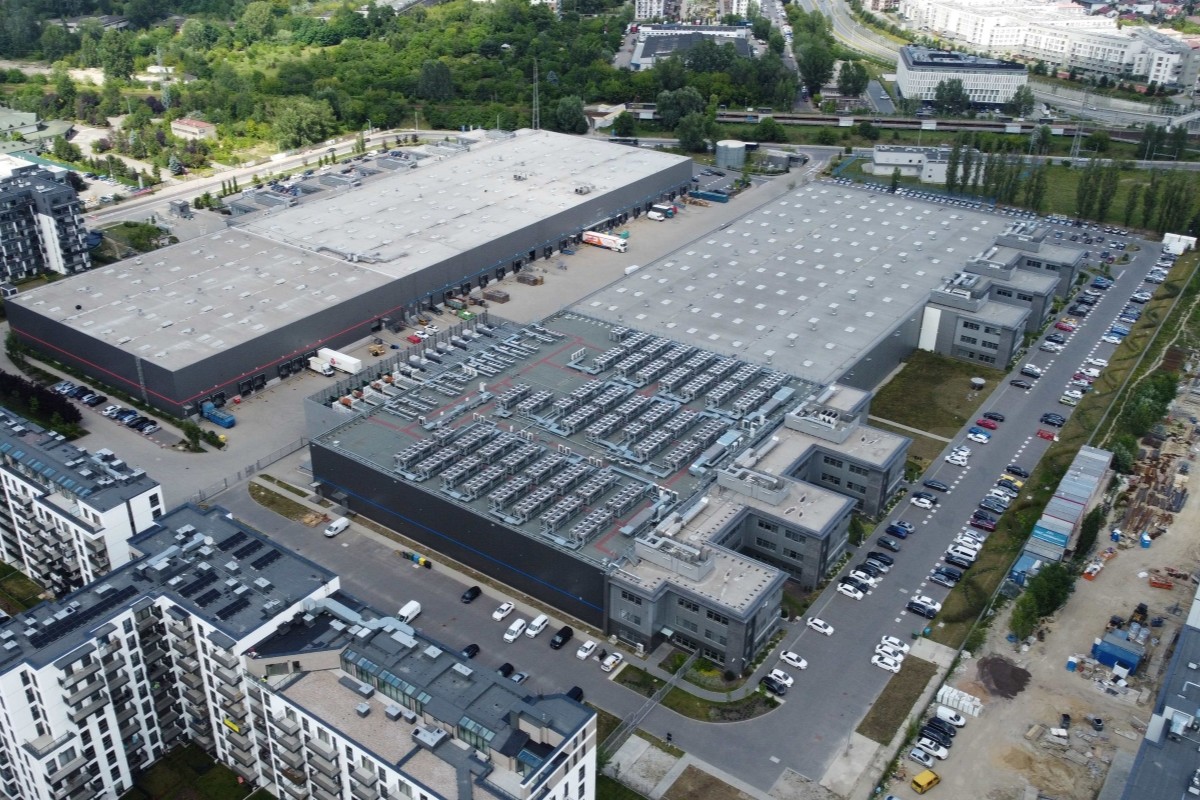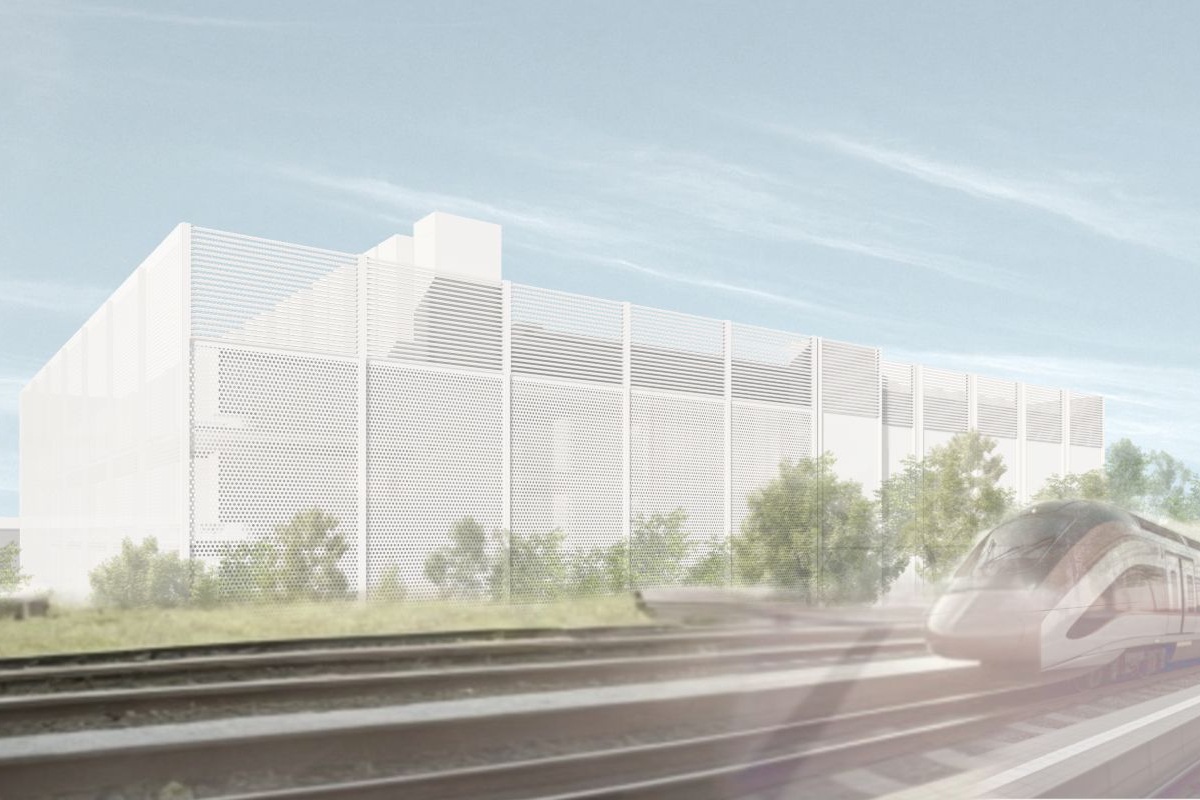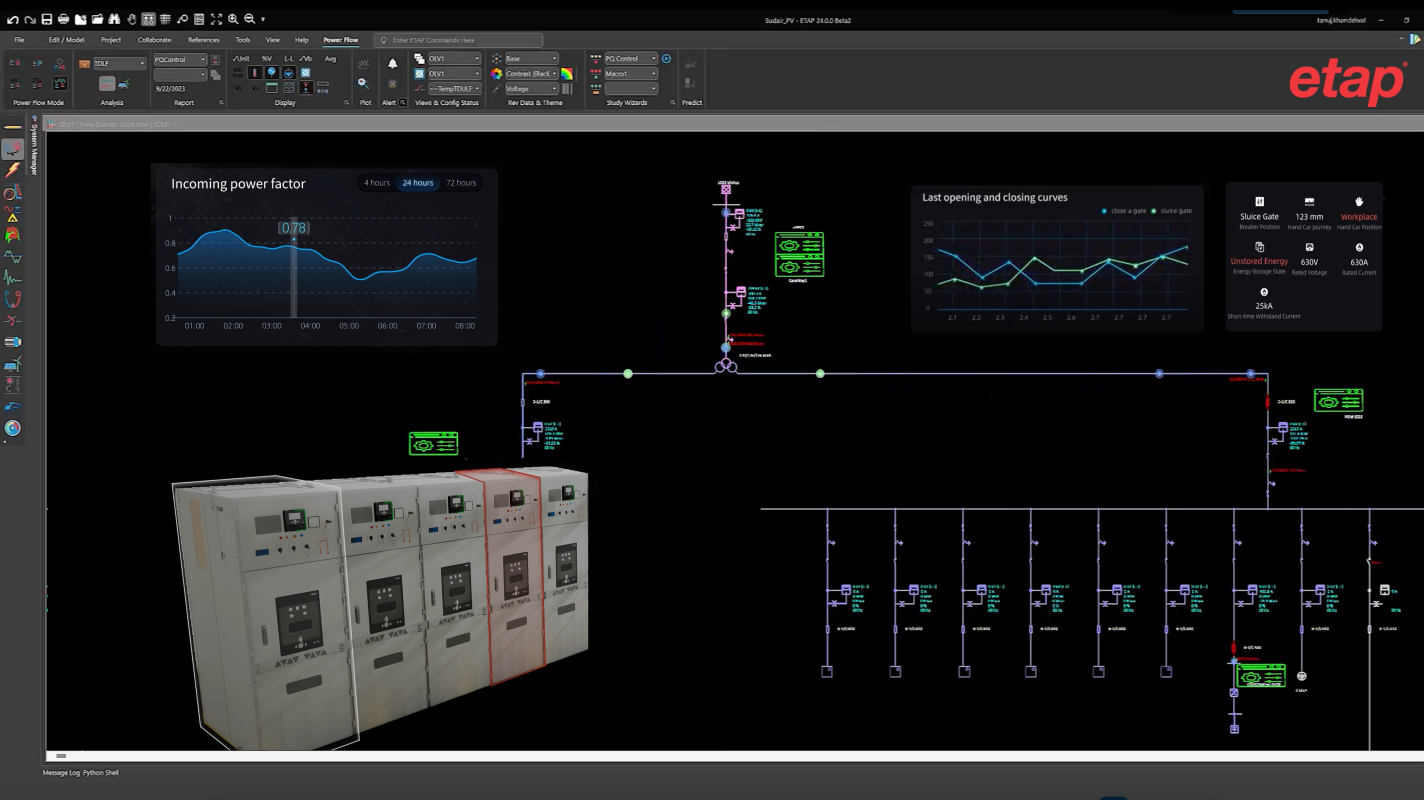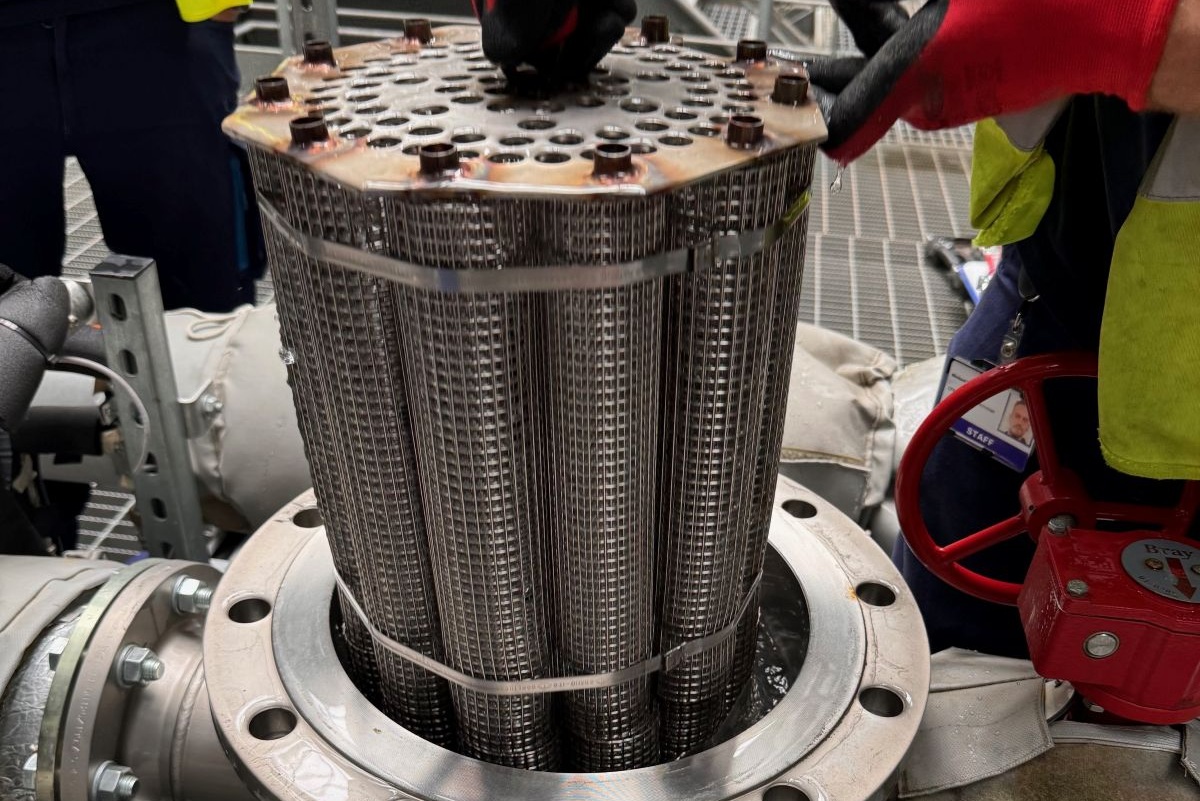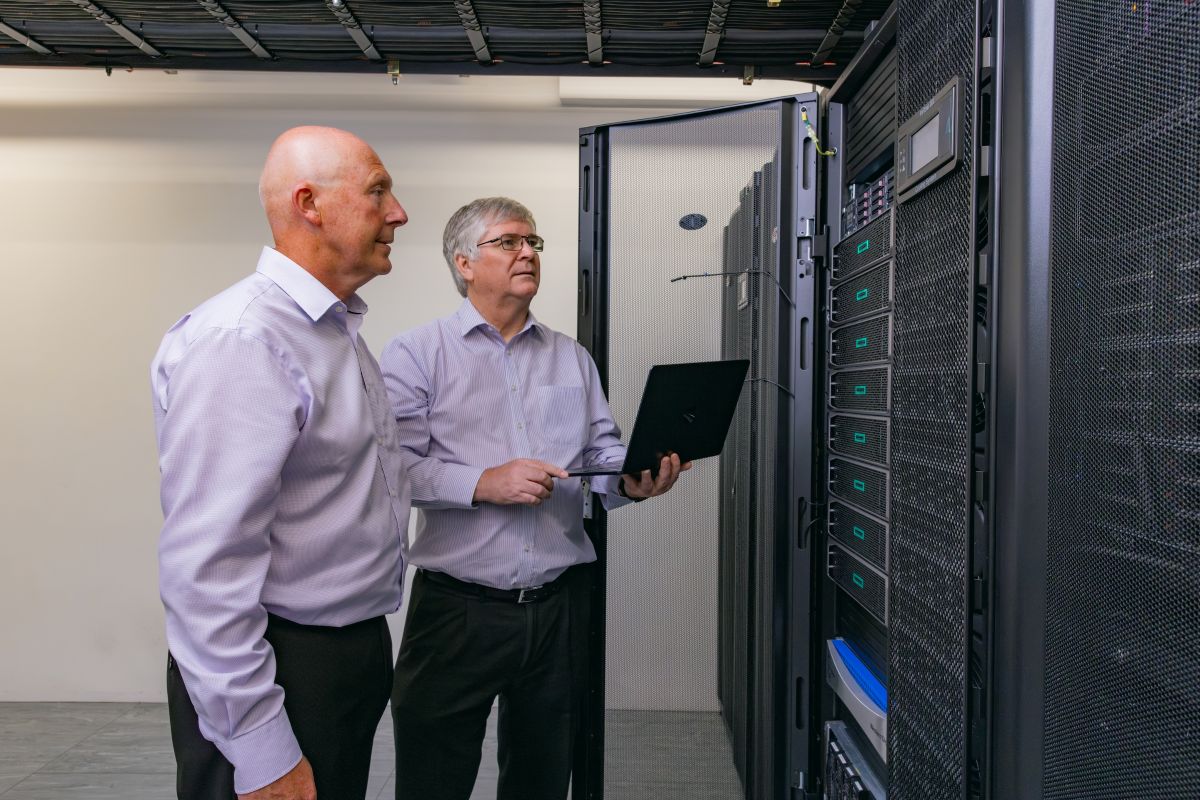Data Centre Projects: Infrastructure Builds, Innovations & Updates
Data Centre Build News & Insights
Data Centre Projects: Infrastructure Builds, Innovations & Updates
Data Centres
News
Aligned announces new mega-scale AI campus in Ohio
Aligned Data Centers, a technology infrastructure company, has announced a significant expansion in Central Ohio with the planned development of its new data centre campus inside the Conesville Industrial Park.
Aligned will develop a 197-acre parcel adjacent to the former AEP Conesville Power Plant. This development aims to revitalise the legacy brownfield site and spur commercial development, converting it into an economic epicentre for Coshocton County and the state of Ohio.
"Through this strategic expansion, Aligned not only reinforces its commitment to providing future-ready digital infrastructure in vital growth markets, but also directly catalyses billions of dollars in investment for the state of Ohio and the Coshocton County community,” claims Andrew Schaap, Aligned’s CEO.
"We are proud to see this investment revitalise a critical legacy site. It lays a powerful foundation, drawing new industries, creating high-quality jobs, and unlocking significant future opportunities for Southeast Ohio."
Representing a multi-billion-dollar investment, this phased development is anticipated to generate thousands of construction jobs and hundreds of high-quality, long-term operational roles, ultimately boosting the local economy.
Data centres in Ohio reportedly contribute significantly to local economies, generating substantial tax revenues that support public services and local infrastructure improvements.
Aligned says it is also committed to local community engagement, including partnerships that support educational programs and environmental initiatives, intending to "ensure a positive and lasting impact in Coshocton County and the surrounding areas."
Aligned’s new multi-building campus has already secured a foundational customer for its first data centre, targeting initial capacity delivery mid-2026.
This is Aligned’s third data centre campus in Ohio.
For more from Aligned, click here.
Joe Peck - 25 July 2025
Data Centre Build News & Insights
Data Centre Projects: Infrastructure Builds, Innovations & Updates
Data Centres
'Construction’s digital lag risks derailing data centre boom'
As the UK accelerates investment in AI infrastructure - committing billions to 'AI Growth Zones' and sovereign compute capacity - a new white paper from integrated collaboration platform Revizto warns that delivery of the data centres required to power the UK’s digital transformation could fall short unless building methods evolve to keep pace with demand.
This risk is underscored by the rapid growth of the UK data centre market, which is expected to more than double in value by 2030, growing at over 13% annually and contributing an additional £44 billion to the economy by 2035.
However, to realise this economic potential, the UK must accelerate the delivery of modern digital infrastructure to meet sustained demand for AI. Currently, the UK construction sector is struggling to keep pace – putting both infrastructure delivery and the UK’s broader economic ambitions at risk.
Revizto’s recent 2025 Digital Design & Construction Report reveals that, despite significant interest in AI across the Architecture, Engineering, Construction, & Operations (AECO) industry, technology adoption remains a critical barrier, with many UK project teams still relying on static, non-integrated tools like email, Excel and PDFs to manage complex and fast-moving projects.
Revizto’s research with over 2000 industry leaders found that:
· 63% of UK AECO professionals are closely following developments in AI and automation.· But for 25% of leaders, tech integration is their top business challenge – ranking above rising costs, talent shortages, and regulatory requirements.· Globally, over a quarter (26%) still rely on email, spreadsheets, and PDFs as their primary digital tools.
The data points to a persistent reliance on non-integrated technology, despite increasing complexity in projects and tightening timeframes. This reliance is slowing delivery and increasing risk on data centre projects that demand precision, speed, and scale.
To meet explosive demand, the digital infrastructure behind AI must be delivered faster and more efficiently. But, as Revizto’s new white paper, The Infrastructure Behind Innovation, shows, delivering at scale and pace brings intense challenges.
Data centre construction demands complex coordination, massive datasets, strict regulatory compliance, high-stakes communication, and tight timeframes – with some projects now moving from concept to full design in as little as ten weeks.
Arman Gukasyan, Founder and CEO of Revizto, comments, “The global data centre boom brings enormous promise, but also new levels of complexity, urgency, and risk.
"The construction industry can’t keep pace with demand using static tools like Excel and PDFs. If the UK is serious about leading in AI, it must fundamentally shift how it delivers the physical infrastructure required for digital transformation.”
To secure the UK’s position as a leader in AI and innovation, the AECO industry must rapidly embrace new technologies and collaborative approaches. By modernising methods and accelerating digital adoption, the sector can deliver the data centre capacity needed to unlock economic growth and ensure the UK remains at the forefront of the AI revolution.
Joe Peck - 23 July 2025
Data Centre Build News & Insights
Data Centre Projects: Infrastructure Builds, Innovations & Updates
Data Centres
News
MP visits Datum's new Manchester data centre
Mike Kane MP, Member of Parliament for Wythenshawe and Sale East, and Parliamentary Under-Secretary of State at the Department for Transport, recently visited UK data centre provider Datum Datacentres’ newly constructed MCR2 data centre in Manchester.
Datum’s latest data centre is the first completed construction project in the £500 million regeneration plan for Wythenshawe. Mike toured the facility, learning about its role in shaping local regeneration and its contribution to supporting businesses across Manchester.
Mike, who himself has lifelong ties to the area, expressed a keen interest in the impact MCR2 looks to have on the region and was keen to understand its role in driving local regeneration and supporting businesses throughout Manchester.
Alongside fostering growth among its future tenants, the construction process emphasised the employment of local contractors wherever feasible. This strategy aimed to strengthen the local economy while reflecting the project's dedication to minimising environmental impact.
Mike Kane MP comments, “It’s remarkable to see a project of this scale right at the heart of the community in Wythenshawe. This facility sets a new benchmark for sustainable, cutting-edge infrastructure while creating pathways to economic growth and wider opportunities for the region.”
During a tour of the facility, Mike was shown how MCR2 demonstrates environmentally sustainable design. As part of the construction process, Datum conducted a carbon impact assessment and integrated sustainability measures, including the installation of efficient free cooling systems to minimise environmental impact, and the incorporation of heat exchange technology to support local community heating initiatives.
The site’s backup generators run on environmentally-friendly Hydrotreated Vegetable Oil (HVO) instead of red diesel. Additionally, the site has a design PUE (Power Usage Effectiveness) of 1.25.
Its data halls are built to accommodate a range of clients - from SMEs to large enterprises - offering flexible power density options and IT infrastructure support. The site also includes advanced security measures, including police-linked on-site facilities.
Matt Edgley, COO at Datum Datacentres, notes, “We were delighted to welcome Mike Kane MP to MCR2 and showcase the culmination of this significant construction effort. The facility symbolises our commitment to revitalising Wythenshawe while bolstering Manchester’s growth as one of the UK’s premier tech hubs.”
MCR2 hopes to play a pivotal role in driving regional economic growth and attracting enterprise activity to Manchester. Its completion represents an achievement in sustainable development and also seeks to open new opportunities for businesses across diverse industries.
Jon Healy, Managing Director EMEA at Salute, says, "It has been a fantastic project to be involved in and it’s great to see the positive impact it will have on the region. This state-of-the-art and sustainable data centre provides the critical infrastructure needed to support the region’s continued growth."
The official launch of MCR2 took place at the end of June and the site is now welcoming visitors who would like to tour the facility.
For more from Datum Datacentres, click here.
Joe Peck - 22 July 2025
Data Centre Build News & Insights
Data Centre Projects: Infrastructure Builds, Innovations & Updates
Liquid Cooling Technologies Driving Data Centre Efficiency
XDS to host 10MW of AI workloads in Saudi's 'Desert Dragons'
UK & Dubai-based XDS Datacentres (XDS), a developer of liquid immersion digital infrastructure, has signed a major agreement with ICS Arabia for the construction and delivery of Riyadh & Jeddah's first 10 MW immersion-cooled data centre.
This collaboration, developed within ICS Arabia's Desert Dragon technology ecosystem, aims to bring advanced computing capacity, sustainability, and scalability to support Saudi Arabia's digital transformation.
Under the terms of the 15-year agreement, ICS Arabia will design, construct, and hand over two 10MW facilities to XDS by Q4 2026. The project will utilise Desert Dragon's Tier III-certified infrastructure and immersion cooling technology to support high-density workloads such as AI, machine learning, blockchain, and other GPU-intensive applications, while the facility will seek to set new benchmarks for energy-efficient, high-performance computing in the region.
The signing ceremony was held on 8 July at Desert Dragon’s headquarters in Riyadh, with key executives from both organisations in attendance.
Ghufran Hamid, CEO of XDS, states, "We are pleased to partner with ICS Arabia on this landmark deployment. The Kingdom represents a key growth market for XDS, and the initial 10MW facilities will showcase the potential of immersion-cooled infrastructure to deliver both performance and sustainability. XDS would like to contribute to Vision 2030 by supplying sustainable infrastructure meeting global ESG standards.
"This isn't just another facility, it's the beginning of a new era. No other data centre company is providing the services XDS will provide, with the switch from air-cooled to liquid immersion. As demand for high-density AI workloads, sovereign compute, and climate-resilient digital infrastructure continues to rise, traditional air-cooled data centres are already struggling to cope. Immersion cooling isn't a niche but an inevitability."
Abdullah Ayed Al Mazny, General Manager at Desert Dragon (ICS Arabia), adds, "Our partnership with XDS reflects our shared vision to deliver cutting-edge data centre capabilities in the Kingdom. Together, we are enabling sovereign digital infrastructure aligned with the ambitions of Saudi Vision 2030."
Immersion cooling at scale
Both Riyadh & Jeddah facilities will feature full immersion cooling with rack densities up to 368kW. This would make them appropriate for services such as AI, GPU-as-a-Service (GPUaaS), cloud-native compute, and hyperscale edge deployment. The design includes redundant N+N power and cooling systems, Tier III certification (TCCF and TCDD), and high-capacity network interconnectivity.
Service and SLAs
Clients of XDS in Saudi Arabia will, according to the company, "benefit from 99.982% uptime guarantees, fully managed colocation services and smart hands, flexible power allocations, GPU-as-a-Service, private cloud, server conversion, customer rack migration and engineering support, Infrastructure-as-a-Service & Software-as-a-Service."
Supporting Saudi Arabia's digital future
The project represents a milestone for both XDS and ICS Arabia as they contribute to building the Kingdom's digital infrastructure and sovereign data capabilities.
The XDS data centre will support national cloud initiatives, artificial intelligence growth, and enterprise workloads that require scalable, low-latency compute infrastructure.
Following the announcement of XDS's successful immersion cooled facility in Dubai, this expansion into the Kingdom seeks to position the company as a key operator deploying immersion cooling at scale for high-density compute across the GCC.
Joe Peck - 15 July 2025
Data Centre Build News & Insights
Data Centre Projects: Infrastructure Builds, Innovations & Updates
Data Centres
News
National Grid starts work on new substation
National Grid, the UK's largest electricity distribution network, is starting work on its new Uxbridge Moor substation in Buckinghamshire which will connect over a dozen new data centres to its network.
The new site forms part of National Grid’s upgrade to its transmission network to meet growing demand for electricity, ensuring it can continue to support the growth of new sectors such as data centres as well as the economic and employment benefits they can bring.
The site will feature two substations – one 400kV and one 132kV – both of which will be indoor gas-insulated facilities (GIS), reducing the footprint of the development by around 70% and minimising its impact on the environment.
Uxbridge Moor will be among the first GIS substations in the country to be free of sulphur hexafluoride (SF6), a commonly used electrical insulator that is also a potent greenhouse gas. Using an alternative insulating gas means the project marks another key step towards National Grid’s ambition to reduce SF6 emissions from its network by 50% by 2030.
Principal contractor Murphy will build the Uxbridge Moor substation, as well as delivering ancillary facilities, underground cabling, and associated work to connect the 400kV substation to the nearby overhead transmission line.
National Grid is planning £35 billion of investment between 2026 to 2031 to connect both large sources of demand (such as data centres and gigafactories) and new sources of electricity generation (such as wind and solar).
The requests from data centres to connect at Uxbridge Moor will require around 1.8GW of new capacity, equivalent to adding a mid-sized city to the grid on the outskirts of London. When built, it will be the largest new substation on National Grid’s network by gigawatt capacity.
The new substation site borders National Grid’s existing Iver 400kV substation in Buckinghamshire, which has reached capacity and cannot be expanded to meet the demand from data centres and other customers for connections in the area.
Energy Minister Michael Shanks says, “Upgrades to the electricity network like this are at the heart of building the industries of our future and support our Plan for Change to deliver economic growth and skilled jobs across the UK.
“It comes as we progress our reforms to the grid connections queue that will speed up the time it takes to get high-growth firms, like data centres and AI hubs, plugged into the grid, while also fast-tracking projects that will scale up clean, homegrown power by 2030.”
Laura Mulcahy, Project Director at National Grid Electricity Transmission, comments, “Our new Uxbridge Moor substation will provide vital access to power for data centres that are at the heart of Britain’s innovation and economic growth. It will enable new jobs and investment in Buckinghamshire, and will support the UK's digital future.
“Alongside these significant benefits, we are working to keep the substations’ environmental impact to a minimum. By using the latest SF6-free, gas-insulated switchgear, we’re reducing the size of this crucial site by around 70% and ensuring its technology is sustainable and resilient long into the future.”
Liam Corr, Managing Director of Energy at Murphy, states, “Since 1951 Murphy has been a leading provider of innovative and integrated energy solutions – today we support groundbreaking transmission and distribution projects across the four countries in which we work.
“We are proud to be delivering this project in the UK’s capital and building on our strong working relationship with National Grid to help to ensure energy security for decades to come.”
For more from National Grid, click here.
Joe Peck - 2 June 2025
Data Centre Build News & Insights
Data Centre Projects: Infrastructure Builds, Innovations & Updates
Data Centres
News
Greykite and White Star deliver Poland's largest data centre
Greykite, an independent European real estate investment firm, its affiliates, and White Star Real Estate have announced several milestones in their Digital Ursus data centre conversion project in Warsaw, including the signing of a long-term lease with a global leader in data centre solutions. This conversion marks the next phase in the site’s transformation from a logistics asset into a data centre hub.
As part of this data centre conversion project, Digital Ursus has successfully secured increased power capacity at the 20,000m² project from 18MW currently to 65MW over the next year. The tenant has committed to a long-term lease with significant investment planned to scale the existing operations on-site.
Located 8km from downtown Warsaw and 6km from Chopin Airport, the site’s positioning highlights its role as a node in Europe’s rapidly growing data centre landscape.
The Polish data centre market is expected to triple by 2029, driven by rising demand for digital services, cloud computing, and colocation solutions. Warsaw remains the key hub, accounting for nearly 70% of the country's commercial colocation and hosting capacity. The rapid growth in data processing is fuelling a growing need for robust digital infrastructure.
Michael Abel, Founder and CEO of Greykite, comments, “We are very pleased with the fast value creation that we have been able to showcase in our Digital Ursus data centre project – having signed a long-term lease with a top data centre operator, relocated multiple existing tenants, and increased the power to 65 MW, all within a period of six months. From the outset, we envisioned the Digital Ursus data centre conversion project with White Star as a platform for long-term, strategic investment in a sector benefitting from very compelling tailwinds. The early success of converting the Ursus property into a modern data centre hub represents a validation of that vision and a clear signal of our long-term commitment to digital infrastructure in Europe.”
Dan Valenzano, Senior Partner at Greykite, adds, “We are excited to be bringing this unique data centre conversion project forward with our partners at White Star, which highlights Greykite’s hands-on approach to driving value creation. The commitment of one of the key tenants from the data centre sector to the property confirms its new strategic significance for digital infrastructure development in the region.”
Dariusz Domański, Managing Partner at White Star, concludes, “Digital Ursus is currently undergoing a dynamic transformation – from a traditional logistics park originally developed by White Star into an infrastructure-ready facility serving modern digital services. This success is the result of close cooperation between all parties and the project’s flexibility, allowing it to respond effectively to evolving market needs.”
Joe Peck - 28 May 2025
Data Centre Build News & Insights
Data Centre Projects: Infrastructure Builds, Innovations & Updates
Data Centres
News
SEGRO and Pure DC announce new London data centre
SEGRO has announced the formation of SEGRO Pure Premier Park Data Centre Limited, a 50:50 joint venture with Pure DC, a global data centre operator with over a decade of experience in the design, build and operation of data centres for hyperscale users.
The joint venture has been created with the intent to develop and deliver a fully fitted data centre in Park Royal, West London. It brings together a 10-acre super-prime industrial site owned by SEGRO and 70MVA of power secured by Pure DC. It represents a highly attractive and profitable opportunity to deliver a data centre in a land and power-constrained key London Availability Zone where there is strong underlying demand; and allows SEGRO to benefit from Pure DC’s technical expertise in data centre fit-out and track record of working with hyperscalers.
This will be SEGRO’s first fully fitted data centre project, building on its experience of delivering powered shells to major data centre operators for over 20 years. SEGRO sees the potential for significant value creation utilising its 2.3GW land-enabled power bank and will seek to optimise and accelerate this over the coming years. The evolution of SEGRO's data centre strategy to include fully fitted data centres will ensure that it can best access the demand in each of its markets and allows the company to deploy capital at scale to generate significant development profits. For each site, SGERO will pursue the model which offers the most attractive opportunity and risk-adjusted return.
Project details
The joint venture intends to develop a circa 30,000 square metre fully fitted, three-storey, data centre on the edge of SEGRO Park Premier Road in West London. The data centre will be constructed to the highest sustainability standards, in line with SEGRO’s Mandatory Sustainability Policy and Pure DC’s Healthier Earth commitments, and will deliver a highly energy efficient offering (including a closed loop liquid cooling system to minimise the potential impact on the local water supply).
SEGRO Park Premier Road is a super-prime West London industrial estate which was acquired by SEGRO in 2009. The 10-acre plot that has been identified for the development is on the edge of the estate where an older warehouse, recently vacated by Matchesfashion, is currently located. SEGRO will contribute the land to the joint venture and will carry out the site clearance and remedial works.
Pure DC will be contributing 70MVA of secured power to enable delivery of a 56MW IT load data centre. Park Royal sits within a key London Availability Zone where there is little competing land supply and limited power capacity, so is expected to present a very attractive proposition for global hyperscalers looking to grow their capacity in one of Europe’s largest data centre markets.
The joint venture will develop the data centre, combining SEGRO’s expertise in planning and development and Pure DC’s experience of delivering operational data centres. The fitout will include mechanical and electrical elements and long lead equipment such as power distribution, cabling and cooling systems. It will not include IT equipment (racking, servers etc) which will be provided by the customer in line with normal market practice.
The joint venture expects to sign a long-term (15 years or more) net lease with a global hyperscaler. Construction will start once planning has been obtained, lease commitments have been secured and financing has been arranged.
The development of this project is expected to generate hundreds of jobs during its multi-year construction phase, which will be complemented by a comprehensive package of support designed to upskill the local community, with an emphasis on fostering a diverse and inclusive future workforce for the technology sector.
In line with SEGRO’s Responsible SEGRO framework, which prioritises investment in local communities, the joint venture aims to establish a range of projects that will bring employment, educational, and environmental benefits to the surrounding area.
David Sleath, CEO of SEGRO, says, “Building on our 20 years of experience in the powered shell data centre market, we have been exploring how best to utilise our skills and 2.3GW land-enabled power bank to maximise the opportunity in this fast-growing sector. This innovative joint venture with Pure DC allows us to develop our first fully fitted data centre, alongside a highly experienced partner with an excellent track record of delivering world-class facilities to global hyperscalers.
“We expect this project to deliver an attractive risk-adjusted return and it will also help further strengthen SEGRO’s expertise in this area, enabling us to optimise and accelerate the significant value creation opportunity within our portfolio.”
Dame Dawn Childs, CEO of Pure DC, comments, “SEGRO choosing to enter into a joint venture with Pure DC for its first fully fitted data centre development demonstrates our capability to create world-class digital infrastructure. Together, we will develop a 56MW data centre in central London capable of handling next-generation cloud and AI workloads.
“This joint venture demonstrates Pure DC’s ability to scale in a rapidly expanding market, creating fresh opportunities for growth and investment. With over 500MW of data capacity in development or operation, Pure DC brings deep expertise building data centres and working alongside hyperscalers. SEGRO Park Premier Road, Park Royal is one of London’s most sought-after data centre locations and will help support the UK’s ambitions for digitalisation.”
Secretary of State for the Department of Science, Innovation & Technology (DSIT), the Rt. Hon. Peter Kyle MP, adds, “This announcement is another powerful endorsement of Britain as a home for tech investment, which will not only bolster the local economy and create job opportunities but also pave the way for a digital and AI-powered future.
“Private investment like this innovative partnership between SEGRO and Pure DC will help us ensure the UK has the digital infrastructure it needs to thrive, helping us harness the power of technology to grow the economy and raise living standards, the central missions in our Plan for Change.”
The clearance of the site will begin, planning will be submitted and marketing of the data centre capacity will commence now that the joint venture has been agreed. It is anticipated that the construction of the shell will commence in 2026 with the fully fitted space available for customer use from 2029.
SEGRO and Pure DC are expected to each retain a 50% share in the project through to completion. No management or incentive fees are payable to either party. In addition to contributing land, SEGRO’s estimated cash equity contribution to the joint venture is expected to be around £150 million over the total construction period. The remaining construction costs will be financed by non-recourse bank financing, prior to the commencement of the construction.
For more from Pure Data Centres, click here.
Simon Rowley - 25 March 2025
Data Centre Build News & Insights
Data Centre Projects: Infrastructure Builds, Innovations & Updates
Data Centres
News
New digital twin to simulate AI factory power requirements
Schneider Electric, an expert in the digital transformation of energy management and automation, and ETAP, a specialist in power system design and operation, are unveiling a cutting-edge digital twin that can accurately design and simulate the power needs of AI factories.
Leveraging the NVIDIA Omniverse Blueprint for AI factory digital twins, Schneider Electric and ETAP are enabling the development of digital twins that bring together multiple inputs for mechanical, thermal, networking, and electrical systems to simulate how an AI factory operates. The collaboration is set to transform AI factory design and operations by providing enhanced insight and control over the electrical systems and power requirements, presenting an opportunity for significant efficiency, reliability and sustainability gains.
While basic visualisation of electrical systems was previously possible, the integration of ETAP and NVIDIA Omniverse technologies enables the creation of a comprehensive AI factory digital twin where multiple dynamics interact seamlessly. ETAP’s sophisticated modelling technology will create a virtual replica of a data centre’s electrical infrastructure and combine it with real-time power system data, advanced analytics, and insights. Intelligent algorithms analyse and predict power consumption and distribution patterns, allowing unprecedented insights into:
- Advanced electrical system design and simulation- Dynamic 'What if' scenario analysis- Real-time electrical infrastructure performance tracking- Advanced energy efficiency optimisation- Predictive maintenance and system reliability assessment- Infrastructure needs based on power usage that can help reduce total cost of ownership
From large-scale training clusters to edge inference servers, AI workloads are driving a significant increase in data centre power consumption. Unlike traditional computing tasks, AI operations - particularly model training and complex inference processes - require substantial computational power, leading to higher rack power densities. As AI adoption accelerates, start-ups, enterprises, colocation providers, and internet giants must rethink data centre design and management to address the growing need for power efficiency, Schneider Electric states.
ETAP and NVIDIA’s collaboration introduces an innovative 'Grid to Chip' approach that addresses the critical challenges of power management, performance optimisation, and energy efficiency in the era of AI. Currently, data centre operators can estimate average power consumption at the rack level, but ETAP’s new digital twin aims to increase precision on modelling dynamic load behaviour at the chip level to improve power system design and optimise energy efficiency.
This collaborative effort highlights the commitment of both ETAP and NVIDIA to drive innovation in the data centre sector, empowering businesses to optimise their operations and effectively manage the challenges associated with AI workloads. The collaboration aims to enhance data centre efficiency while also improving grid reliability and performance.
“As AI workloads grow in complexity and scale, precise power management is critical to ensuring efficiency, reliability, and sustainability,” says Dion Harris, Senior Director of HPC and AI Factory Solutions at NVIDIA. “Through our collaboration with ETAP and Schneider Electric, we’re offering data centre operators unprecedented visibility and control over power dynamics, empowering them to optimise their infrastructure and accelerate AI adoption while enhancing operational resilience.”
“This collaboration represents more than just a technological solution,” adds Tanuj Khandelwal, CEO of ETAP. “We’re fundamentally reimagining how data centres can be designed, managed, and optimised in the AI era. By bridging electrical engineering with advanced virtualisation and AI technologies, we’re creating a new paradigm for infrastructure management.”
Pankaj Sharma, Executive Vice President for Data Centers, Networks & Services at Schneider Electric, remarks, “Collaboration, speed, and innovation are the driving forces behind the digital infrastructure transformation that’s required to accommodate AI workloads. Together, ETAP, Schneider Electric, and NVIDIA are not just advancing data centre technology - we’re empowering businesses to optimise operations and seamlessly navigate the power requirements of AI.”
For more from Schneider Electric, click here.
Simon Rowley - 19 March 2025
Data Centre Build News & Insights
Data Centre Projects: Infrastructure Builds, Innovations & Updates
Data Centres
News
Data centre keeps its cool with technology from Spirotech
Spirotech, a water quality specialist, has fulfilled an order for 32 bespoke hi-flow SpiroTrap dirt separators for a data centre installation in Hertfordshire.
Keeping such facilities dirt-free is critical. Spirotech worked on the project with trusted contract service partner, Engineering Support Solutions (UK), based on the Slough Trading Estate in Berkshire.
ESS (UK) consulted with its prestigious data centre client and, after assessing their needs, designed the pipe connections and the bespoke sizing of the units to reduce the number of infrastructure changes to site. Spirotech supplied with this information developed the stainless-steel production units. Other specification changes included a top demountable lid for easy maintenance access and test points on inlet and outlet arms.
The ‘off-the-shelf’ models are made from carbon steel and tin and are equipped with a bottom demountable lid.
Lewis Hill, Managing Director of ESS (UK), comments, “After a series of design meetings, both on-site and with Spirotech, the adapted units were successfully manufactured within 22 weeks. We are extremely pleased with the outcome, as the final product is a highly effective, bespoke piece of equipment that perfectly meets the client’s needs.
“The data centre has three open cooling tower systems used for cooling the data halls within the building and they had strainers in place to remove the sediment being pumped around the system. However, performing maintenance on them required shutting down the cooling system, which, as you can imagine, was far from ideal for the site.
“We were pleased to have bespoke dirt separators engineered for site which has reduced down time for the client as well as provided a kit that outperforms their original design. As a business we quality assure everything we use and know that the Spirotech equipment, along with their technical ‘back-up’, won’t let us down.”
Steve Simmonds, Special Projects Engineer for Spirotech, adds, “The data centre is delighted with the installation and performance of the units. They are removing much smaller particulates than before and are, as a result, making substantial savings in terms of maintenance time and money.”
The bespoke SpiroTrap unit is able to remove very small particles from 5um and separates and removes dirt from the system whilst in operation. In case of severe pollution and/or maintenance, the unit is demountable and ensures no unnecessary downtime.
ESS UK primarily specialises in fluid movement, and offers the support, installation, maintenance, repair of pump equipment and wet waste service.
For more from Spirotech, click here.
Simon Rowley - 17 March 2025
Data Centre Build News & Insights
Data Centre Projects: Infrastructure Builds, Innovations & Updates
Data Centres
News
Sustainable Infrastructure: Building Resilient, Low-Carbon Projects
Schneider Electric increases DC sustainability for insurance group
Schneider Electric, a specialist in the digital transformation of energy management and automation, has worked with its EcoXpert Partners, on365, to deliver a series of data centre and critical power projects to Markerstudy Group - one of the fastest growing providers of general insurance services for more than eight million customers across the UK.
Working together with on365, a provider of resilient and energy efficient critical physical infrastructure and utility services, Schneider Electric and its longstanding EcoXpert Partners devised an upgrade and consolidation strategy for Markerstudy’s electrical infrastructure, data centres and networking systems. Equal consideration was given to the need for increased reliability, security, and energy efficiency, while helping the organisation to better manage and scale its distributed systems.
As part of the strategy, the Group chose to standardise on key components from Schneider Electric’s EcoStruxure for Data Centres portfolio, including its Galaxy V-series three phase UPS’s and APC Smart-UPS RT single phase UPS, EcoStruxure Row Data Center solution, InRow DX cooling units and Chilled Water systems, APC Racks and PDUs and EcoStruxure IT Expert DCIM software.
Additionally, on365 secured a strategic five-year, Managed Service Level Agreement (SLA) to manage and maintain all critical power and cooling infrastructure on behalf of the insurance group – helping not only to improve the efficiency and resiliency of its systems, but to reduce its carbon emissions.
Sustainable expansion
Markerstudy Group was founded in 2001 and today serves over eight million customers, employing more than 7,000 people across 40 brands. In 2020 it acquired Co-op Insurance’s underwriting business, followed by BGL Insurance and Lloyd’s broker Clegg Gifford in 2021, and Atlanta Insurance in 2024. This expansion presented several technological challenges, which included integrating multiple technology systems, while managing a diverse portfolio of digital infrastructure, including several data centres and IT systems distributed across its offices and customer support centres.
The Group is fiercely committed to sustainability, aiming to reduce the energy usage and carbon emissions across its operations. To address these goals and stay updated on new technological advancements, it continues to collaborate with on365 and Schneider Electric, while working with net zero consultancy, Energise, and mapping its operations to the Greenhouse Gas Protocol (GHG), which earned it a Bronze sustainability rating from EcoVadis.
Modernisation strategy
Markerstudy’s strategy to standardise on Schneider Electric technologies, and to modernise its infrastructure portfolio began in 2012, when it first commissioned on365 to design and build a data centre at its Chesterfield contact centre. The data centre utilised Schneider Electric’s EcoStruxure Row Data Centre solution, together with InRow DX cooling units to maximise energy efficiency, and minimise the threat of downtime from thermal shutdowns.
During 2023, on365 implemented a new main substation Transformer and Primary Switchboard to replace 30-year-old, legacy electrical equipment. Designed using IoT-enabled components for ease of monitoring and management, the new system has future-proofed Markerstudy for the integration of renewable energy at its offices, while providing key infrastructure for new EV chargers.
Additionally, on365 provided a turnkey data centre solution at Markerstudy’s Tunbridge Wells headquarters. To meet its fast-growing capacity requirements while supporting the business’ expansion, the data centre has undergone a significant technology refresh to increase the efficiency of its cooling systems. It is also using Schneider Electric Galaxy VS UPSs to enhance the resiliency of the site.
Outside of its main data centres, on365 has improved the resilience of Markerstudy’s edge computing environments across its regional office portfolio and call centres. This includes the installation of Galaxy VS UPS equipment at its Manchester office to support the critical network and the unified communications connections within its main data centres, as well as APC Smart-UPS UPS to protect the network racks on different floors of the building.
Markerstudy was also an early adopter of Schneider Electric’s EcoStruxure Data Center Expert software and now uses Schneider Electric’s EcoStruxure IT Expert DCIM solution, coupled with a digital services program from on365, to provide real-time monitoring, remote management and maintenance for its critical infrastructure.
Enhanced control
By working with on365 and Schneider Electric, Markerstudy has been able to establish greater control over its IT and network environments. This has enabled it to monitor and manage them for better efficiency and to lower the emissions associated with data processing and storage, as well as those associated with its IT and data centre services.
In standardising on Schneider Electric Galaxy V-series UPS and APC Smart-UPS, Markerstudy has opted for best-in-class levels of efficiency and reliability, while leveraging Green Premium technologies to help with carbon reporting. Additionally, the energy savings resulting from its new Transformer and Switchboard have contributed to Markerstudy’s sustainability ambitions, reducing the carbon footprint of its IT operations, while fast-tracking the transition of its van fleets to EVs.
“The Markerstudy board has consistently supported our investment in more efficient data centre physical infrastructure, enabling the IT Team to improve the PUE of our data centres, and accommodate our technology requirements as the company continues its growth trajectory,” says Nick Ovenden, Chief Technology Officer at Markerstudy Insurance. “Working with on365 and Schneider Electric has been central to the execution of our digital infrastructure and upgrade strategy, as well as meeting the sustainability ambitions for our IT services.”
“From day one we’ve set out to work as an extension of the Markerstudy Insurance Group,” comments Carl Richardson, Technology Manager at on365. ‘By understanding their aims and objectives and immersing ourselves in the culture of their technical team, we now deliver a nationwide service which supports the design and deployment of efficient and reliable infrastructure, and the delivery of key insurance products for its UK customers.”
“Today’s data centres and IT technologies are vital to support the UK’s thriving enterprise sector,” adds Mark Yeeles, Vice President, Secure Power division, Schneider Electric UK and Ireland. “Our work together with on365 showcases the important role of data centres as critical national infrastructure and demonstrates how our ecosystem can ensure customers like Markerstudy remain at the forefront of UK Insurance services while achieving their sustainability goals.”
Schneider Electric’s case study with Markerstudy Insurance Group and on365 is now available for download.
For more from Schneider Electric, click here.
Simon Rowley - 25 February 2025

Head office & Accounts:
Suite 14, 6-8 Revenge Road, Lordswood
Kent ME5 8UD
T: +44 (0)1634 673163
F: +44 (0)1634 673173





